Lovely discussion with students in my not-quite criminology classes about imagery of crime using Europol’s SOCTA 2017. The report crisply and directly illustrates Europol’s assessment of major threats in the field of drug trafficking, human trafficking and cybercrime. Not surprisingly for a report subtitled ‘Crime in the Age of Technology’ the emphasis is on payment systems, crime as a service, and manipulation. Students made illuminating points about the focus on high-tech, which frames organised crime as flexible, innovative and tech savvy. The framing of tech supported crime is depersonalised and flattened. As Collier and colleagues (2020) pointed out this image of exciting, just in time tech crime is belied by the mundane routinisation of much labour in the crime tech world. Tending a server 24/7 does not provide the hackerish thrills promised by CSI: Cyber.

One image stands out for me: the glowing eyed balaclavas which look like Tron versions of the Provisional IRA. The image suggests anonymity, surveillance and an unknowable threat. It functions as a logo for organised crime groups in the document. It is a common feature of high level documents like this that they tend to abstract the activity they discuss from a specific context and place. That is understandable given the audience and the process of writing it. It has the effect of making it seem like tech enabled OCGs haunt the crime scene and appear out of time and place. The conclusion is that the imagery of crime in documents like this is shared between organisation, and similar imagery occurs in the reports of private research and investigation groups. Studying how these images and framings circulate is the work of cultural criminology and this would make an effective study.


Comments by Angus Bancroft